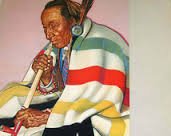Winold Reiss
Winold Reiss (pronounced Vine-old Rice) came to America from Germany in 1913. Born into a family of artists, he settled into the New York art scene, but was obsessed with the desire to paint Indians out west. He finally traveled to Browning, MT in 1919 and immediately started capturing Native likenesses with his colorful, art-deco paintings. As told in the NY Tribune in 1935, Reiss said, “I had read books about how you must always approach an Indian with ceremony, but I just ran up to the biggest, finest looking one, and slapped him on the back and began telling him how I had come all the way to see my red brothers and paint them.” On this visit, Reiss is reported to have made two paintings a day for 18 days, and ultimately created over 250 images in his summer visits to Glacier.
Eventually, he was hired by the Great Northern Railway to create portraits for advertising their star destination, Glacier National Park. Reiss spent time as Artist in Residence and with his brother, hosted an art school at nearby St. Mary’s for four summers. His lifelike, respectful portrayals of the Blackfeet captured the authentic designs of beadwork, fancy dress, jewelry and lifestyle of the Native American culture. They came to be printed by the railway on calendars, playing cards, menus and eventually as two individual print sets – all still hold value today. From 1927 on, Great Northern used Winold Reiss’ paintings for their next 30 years of advertising.
He died on August 29, 1953 in New York City. His Blackfeet friends spread his ashes along the eastern edge of Glacier National Park.



